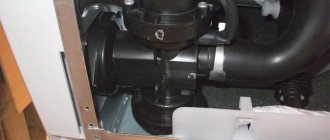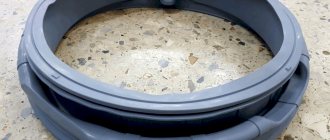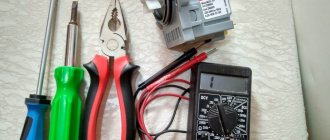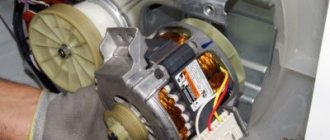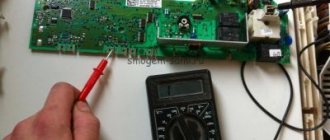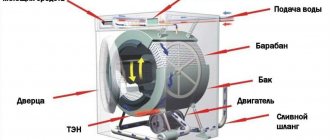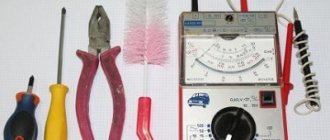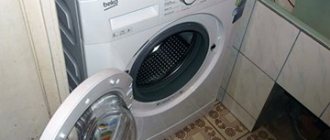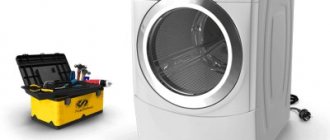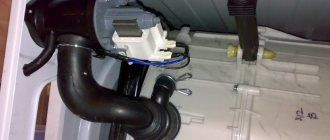With a broken pump, the Whirlpool washing machine will not be able to function normally. This structural element is activated during each washing cycle.
Over time, its components wear out, which leads to breakdown. This process can be accelerated by non-compliance with operating techniques.
To learn how to repair the pump of a Whirlpool washing machine yourself, read the article.
Drain pump device
The drain pump for a washing machine has the following technical characteristics:
- power consumption - usually from 25 to 40 W;
- type of fastening to the volute - screw or fastening with latches;
- contact arrangement - paired or separate;
The pump in the washing machine differs not only in appearance, but also in the type of “snail” filter installed inside them. Very often the filter becomes clogged, and in this case the water is not completely drained from the chamber, then the dirty liquid stagnates and an unpleasant odor appears inside the drainage system. In this case, it is necessary to check the condition of the filter. You will need some tools, since the device cannot be removed with bare hands. The filter can be cleaned and the problem may be resolved.
The internal structure looks something like this:
The pump rotor is a permanent magnet in the form of a cylinder, which is located in a plastic casing. When the system starts up, the rotor first turns on, then the impeller, located on the shaft at an angle of 180 degrees, begins to move. The impeller relative to the armature should have a small stroke; this is necessary for normal engine starting, since there is a load due to water.
The rod, or otherwise the magnetic core, has two insulating windings that are connected to each other. The whole design is similar to an asynchronous motor, where there is also a moving and a stationary part. The moving part is a rotor in the form of a cylinder, and the stationary part is a magnetic core with windings.
This is how a simple washing machine pump works.
For example, if the impeller of the impeller falls off from the pump, this will inevitably lead to the need to replace the pump, since it cannot be repaired.
The washing machine's circular pump only allows liquid to flow in one direction.
For example, in the pump of a Samsung washing machine, a sealing collar is used to block the independent entry of liquid. This is necessary to prevent water from leaking into the bearing. Also, such mechanisms are equipped with a rotor shaft, which passes through a central collar bushing, which is crimped in the form of a spring ring.
Before the cuff is secured in the desired bushing, it must be lubricated with a special technical lubricant. The product is applied in a thick layer so that when starting work it gets into all the necessary gaps. This action has a positive effect on the operation of the mechanism and significantly increases its service life.
Preventive measures
You can protect your washing machine from breakdowns, especially from clogging of the pump (drain sediment). To do this, you need to adhere to the following recommendations:
- Carefully check the pockets of items before washing for the presence of foreign objects (for example, small money, metal or plastic objects). These parts can damage the inside of the pump or block the drain hose.
- Soften washing water. Synthetic products (Kalgon, Uplon, Kupava) and special filters will help with this. The former remove plaque formed by small particles of salts and metals (components of hard water), and filters prevent these particles from penetrating inside the washing machine.
- Do not overload the device (load the amount of dirty laundry into the drum as recommended by the manufacturer).
Regular cleaning of the filter, which is located between the pump and the drain hose, will also help protect the machine from such damage. By following these rules, you can protect the device from damage.
[custom_ads_shortcode3]
How to remove the drain pump
Before cleaning the washing machine pump filter, you will have to remove it from the washing machine body.
The following standard set of tools will be required:
- screwdrivers;
- wrench;
- bucket or basin for draining liquid.
Locating the Pump
The next task will be to study the operating instructions for the washing machine. For what? To find out exactly where the part we need is located.
Not all brands of washing machines have the pump in one place. Therefore, depending on the brand, you will have to act differently and with a special approach.
Location of pumps for Indesit, Samsung, Veko, Ariston, Argo and LG
For example, cleaning the pump of the Indesit, Samsung, Veko, Ariston, Argo and LG washing machines will be much easier, since you can squeeze through the bottom of the case to the part. In some of them it is completely absent or removed without much effort.
To do this you need:
- Through the special door, which can be unscrewed using a flat screwdriver, get to the screw holding the filter and unscrew it.
- Pour all the liquid into the prepared container. To do this, you only need to twist the filter clockwise to completely drain the liquid.
- Afterwards you will have to rotate the filter counterclockwise, pressing it in and pulling it out through the bottom. The machine must first be placed on its side.
- Disconnect everything (clamps, wires), pull out the pump.
Location of pumps for Bosch, Siemens
To get the drain pump in machines of the Bosch and Siemens brands, you need to disassemble the facade of the device:
- Remove the compartment intended for filling detergents, remove the self-tapping screw.
- At the bottom, remove and remove the retaining screw. Now you can remove the front panel too.
- After detecting the panel inside the unit, additional screws are unscrewed, the cuff is disconnected, the rubber band is removed from the hatch, and the clamps are released.
- The pump is removed, the liquid is drained, and the remaining parts are removed, including the hose.
Location of pumps at Electrolux, Zanussi
In Electrolux and Zanussi washing machines, the pump is removed through the cover at the back:
- The clamps on the back wall of the device that hold the hose are unscrewed and it is removed.
- Unscrew the screws and remove the panel.
- Disconnect the wires, remove the pump, disconnect all parts from it.
What will be needed for verification?
The diagnosis itself is not difficult if the following tools are available:
Rice. 1 - Diagnostic tools
- multimeter (a tester is enough);
- medium-sized pliers;
- screwdrivers – Phillips and flathead;
- awl.
To find out if there are problems with the drain pump, it must be removed from the machine.
What to do to eliminate noise and crackling in the pump
To find the cause of a breakdown, you don’t have to buy an entire store of power tools; the main work involves unscrewing and removing parts. Before you begin disassembly work, take the time to check the drain filter. Its malfunction is the most likely cause of the noise.
Checking the drain filter
In popular brands of washing machines, such as LG or Ariston, this part is located in the lower right corner behind a small panel held in place by latches. You can remove it with your hands or help yourself with a screwdriver to press the latches. Now follow the instructions:
Use a rag or low container to catch the water that comes out of the filter. Turn the filter cap counterclockwise. Take out the filter and inspect it. Remove visible blockages with your hands, then rinse the part under the tap. Place the element in place, screwing it tightly. Run a test wash and see if the hum and noise are gone.
If the filter is clean and no significant debris is found in it, then check the drain hose and pump further. Inspecting them inevitably requires disassembling the washing machine body. The pump is removed differently in different brands of cars.
- So, “Whirlpool”, “Samsung”, “Elgie”, “Ardo”, “Indesit” and “Ariston” do not have a bottom cover, so it is enough to put the SMA on its side to get to the pump.
- If you are the owner of a Bosch, Siemens or AEG machine, then you can only reach the pump from the front.
- In the Zanussi and Electrolux SMs, the pump is removed through the rear wall of the housing.
Manufacturers usually provide entire instructions in the user manual. But if the manual is lost without a trace, our photo instructions in the article “How to clean the pump in a washing machine” will come to your aid.
After you clean the pump, replace it or replace it with a new one if cleaning does not help. If the pump is still noisy after this, check other parts.
Checking the pipe and hose
If the filter and pump are in perfect order, and noise and hum still accompanies every wash, then the drain hose and pipe are likely to be clogged or broken. Having disassembled the SM body, you need to remove the clamp holding the pump and hose (disconnect the other end of the hose from the sewer).
Remove the hose from the washer and rinse under the tap using a cable with a brush at the end. After cleaning the hose, install it in place and check the operation of the machine.
If this does not help, carefully pull off the drain pipe - it may be clogged, which is where the noise comes from
Even though the rubber pipes are wide in diameter, debris can still accumulate in them, so pay attention to cleaning the pipe. At the same time, inspect it for damage and leaks so you can quickly replace the part.
If you have done everything we suggested and the car still makes noise, you should contact a specialist.
Repair
It is best to take a broken circulation pump to a specialized service center, especially if it is still under warranty. Most of the models currently on the market, unfortunately, are non-separable or partially disassembled, so if problems arise with its internal spare parts, entire units or the pump assembly must be replaced. If the warranty period has already expired, and the design of the pump allows you to disassemble it and get to all the main components, then, if you have the appropriate skills, you can carry out the repair yourself.
Having determined the cause of the malfunction from the table above, it is enough to disassemble the pump, as indicated in the paragraph on prevention and maintenance, and replace the faulty part.
The main elements in the pump control unit are:
- 1-5 microfarad capacitor;
- terminal block for connection;
- speed controller.
Due to the small capacitance of the capacitor, you can check it using a multimeter, which has a built-in C-meter with a limit of up to 20 µF
If the readings deviate significantly from the nominal value, the capacitor should be replaced; it is important to maintain the polarity of the connection and be sure to have its voltage tolerance. For a conventional single-phase motor, capacitors with a tolerance of up to 450 V are used
The speed controller assembly is replaced with a new one. It is enough to disconnect it from the terminals, remembering the position of each pin and connect a new one.
The terminal block must be perfectly clean, dry and without signs of obvious overheating or burnt. If the above problems exist, then it should be replaced with a new one, the same or similar in the number of connections.
Popular models of circulation pumps are from the manufacturers Wilo, Ggrundfos, Dab. Not least due to their reliability. You can expect these pumps to break down within the warranty period only if the recommended operating conditions are violated. However, during the post-warranty period, Wilo often has problems with support bearings. Only replacing them helps.
Ggrundfos and Dab can “please” the impeller to become overgrown with scale for high-temperature heating systems, as well as silting of the stator cup. It is better to prevent these problems by installing a good filter and preparing the water. Otherwise, breakdowns are often justified by external problems.
How to clean the drain filter in a washing machine - step-by-step instructions
We will clean the trap filter step by step, as our service technicians do.
1. For safety, turn off the water supply and disconnect the machine from the network. You may have to lift the equipment or move it from its place. Agree that you don’t want to flood the floor with water or get an electric shock while working.
2. Find where the filter is on the washing machine and open the hatch cover, or remove the false panel from the bottom of the body. The hatch is usually fixed with a latch, and the lid is held tightly. Use a flathead screwdriver or a flat-edged cutlery knife to pry the lid open. In some models, the lid can be easily opened by hand.
The false panel is held on by latches or hooks and can be removed in two ways:
- moving towards you (sometimes you first need to pry off the top of the panel with a screwdriver)
- sideways, usually from right to left.
3. Prepare a rag and drain the remaining water from the washing machine. The water in the car is completely pumped out only from the tank. There is always some water left in the drain system, of which the filter is part. It will spill out when you unscrew the filter. Therefore, to avoid flooding the floor, place a rag under the machine or lift the body and place a flat basin or other container. In some models, there is no need to lift the body of the washing machine; the hatch or folding handle of the filter is a chute through which water flows into the attached container.
Even if you used the emergency hose, a little liquid will still remain in the washing machine. To drain it completely, carefully turn the drain filter plug 45-60 degrees counterclockwise and let the remaining water drain into a nearby container or onto a rag. If the plug is additionally secured with a special screw, as, for example, in Candy Holiday 181 machines, then first loosen or unscrew it using a screwdriver.
4. Completely unscrew and pull out the filter.
For some brands, for example, AEG, LG, Electrolux, Zanussi, you first unscrew the plug, which acts as a water stopper, and then pull out the filter.
5. Clean and rinse the filter. First, we take out large debris - wool, threads, foreign objects. Then we take a regular dish sponge with an abrasive layer and clean the surface of plaque. Then rinse the filter thoroughly under running warm water.
Be sure to check the hole in the machine and clean it of any remaining debris. At the same time, wipe off dirt and plaque with a damp cloth or sponge.
6. Check the drain pump. Don’t forget to look into the drain pump, there may also be dirt left there. Shine a flashlight into the hole and remove any debris that has slipped into the pump. To check, rotate the impeller; nothing should interfere with its rotation.
7. Put the filter in place. We insert it into the hole evenly, without distortions and tightly, but carefully. Tighten the filter plug clockwise. We screw in the fixing bolt, if there was one (for example, in Candy Holiday 181). In some models of AEG, LG, Electrolux, Zanussi, you must first insert the filter into the slot and then screw on the locking cover.
8. Turn on the machine and check for leaks. To avoid flooding the floor during washing, we check the equipment for water leakage from the filter. We put on a test rinse and see if there are any drops or streams from under the filter cover. If everything is dry, close the hatch or replace the false panel and the washing machine itself.
Information on how to properly clean the drain filter in your washing machine model is in the user manual. If you forget where it is, use our database of instructions for washing machines. For cleaning information, see the “Cleaning and Maintaining Your Washing Machine” section of the manual.
How much do the services of a master cost?
If you cannot replace the pump on your own, you must seek help from a specialist. The services of a master cost about 1,800 rubles. The final price depends on the complexity of the work, as well as the model of the washing machine. You will have to pay for the new part separately.
You can find a master by looking at an ad on the Internet or in a newspaper . If the device is under warranty and the breakdown was not due to the user’s fault, repairs will be performed free of charge.
To ensure that there is no breakdown after repair, you must ask the specialist for a receipt of payment and a warranty card. You should also make sure that a new factory pump is installed in the device, and not a part removed from an old machine.
Preparatory activities
Before cleaning the filter, you should thoroughly prepare for the upcoming actions. Its dismantling is most often accompanied by the release of dirty water, which can flood expensive floor coverings.
To prevent possible troubles, you need to do the following:
- pull out the built-in unit from the kitchen cabinet, first disconnecting it from the communications system;
- cover the floor covering at the work site with unnecessary rags or oilcloth;
- Place a large container directly under the filter cover.
If before disassembling the washing machine has completed a full operating cycle with rinsing, you will need to pause for draining. If this is not done, then when disassembling the filter, the volume of spilled water will increase noticeably.
Dismantling
Upon completion of the preparatory operations, they proceed to removing the filter from the machine and then cleaning it.
To do this, you will need a simple tool kit consisting of a screwdriver (sometimes the filter is additionally attached to a bolt), a plastic hammer and an old toothbrush.
Utility materials and cleaning products will require a piece of flannel fabric, rubber gloves and citric acid.
The procedure for dismantling the filter trap is as follows:
- First, you should grab it by the protrusion on the cover and, turning it counterclockwise, pull it towards you.
- If this cannot be done due to accumulated dirt and scale, you need to use a plastic hammer and lightly tap it on the body.
- After unscrewing the filter base completely, you will then need to remove it and get ready to clean it.
If, when unscrewing, the housing does not move even after tapping on it, this means that it is additionally secured with a bolt. When carrying out these procedures, not only the filter dirt catcher needs to be cleaned, but also the cavity in which it is attached.
To do this, wear rubber gloves and remove all foreign objects (buttons, coins, etc.) from it. After this, use a toothbrush to sweep away small particles of dirt and remove accumulated mucus from the walls with a flannel.
Finally, all that remains is to thoroughly wipe the walls of the cavity with a damp cloth or rags and leave it to dry for a while.
Cleaning procedure
To clean, you will need to do the following:
- Manually remove dirt and hair deposits adhering to the parts.
- Rinse the filter attachment under running water while cleaning it with a toothbrush or soft brush.
- Let it dry and inspect for contamination.
- Upon completion of cleaning, the filter device is installed in place.
- To do this, insert it into the cavity and, rotating the body clockwise, fix it in it.
If it is not possible to completely remove dirt while cleaning the filter element, you need to soak it in a citric acid solution for a couple of hours. At the same time as cleaning, this will get rid of limescale and unpleasant odors.
The filter is soaked in cold water, since at low temperatures citric acid dissolves better and the plastic body of the device does not deform. In addition, hot water causes the seal to lose its elasticity, which will disrupt the tightness of the joint.
Prevention measures
The reasons why washing machines become clogged, be it Whirlpool, LG, Bosch or any other brand, are garbage, hard or dirty water, and low-quality detergents. To reduce the risk of pump clogging, it is recommended:
- Use only special washing powders for washing - for washing in SMA.
- Wash things in washing bags to prevent small parts from getting into the drum and tub: buttons, locks, etc.
- At the entrance to the machine, you need to install a cleaning filter so that perfectly clean water, free of impurities and rust, flows into the machine.
- The user, having noticed a decrease in the performance of the device, must disassemble the device in a timely manner in order to clean the filtering devices and pump.
- Carefully check pockets of clothing before loading into the drum.
- Clothes that are too dirty should be soaked before washing to remove large fractions of dirt.
- Use anti-scale agents when washing.
- When the wash is finished, check the drainage of water from the tank - it should pour out completely.
If you try, you can complete the task of cleaning the water pump yourself, without the help of a specialist.
It is important to follow the instructions and follow the procedure. Timely cleaning of blockages will prevent pump breakdown and extend the life of your machine.
Increased demands are placed on the technical and operational characteristics of pumps. They must operate smoothly in the most adverse conditions. Therefore, manufacturers strive to minimize the number of moving, rubbing parts. The devices can withstand loads with dignity, work for years, and sometimes decades, without repair or replacement, but they all need cleaning. All parts of the devices are tightly fitted to each other and “stick” during operation, so disassembly may be difficult. How to properly disassemble and clean the pump?
Surface pumps are easier to disassemble than submersible pumps, because... their cases are not so sealed
Dismantling the pump through the bottom of the MCA
This design is typical for the brands Whirlpool, Indesit, Samsung, LG, Ariston, Beko, Ardo, Candy. Access to the pump is considered the easiest.
Do this:
- To remove the pump, you can tilt the washer backwards. But if there is no one to hold the equipment, then it is better to lay it on its side. First check if there is water in the powder receptacle.
- If the bottom of the machine is covered with a panel, unscrew the screws and remove it.
- Having approached the pump, loosen the pipe clamps and disconnect them from the pump body.
- After disconnecting all wiring and unscrewing the mounting screws, remove the pump.
After dismantling, the part must be cleaned. Read about it below.
Clean the hose when it is completely clogged
If water removal from the washing machine completely stops, a second cleaning method will be required, in which you will need to completely disconnect the hose from it. For this you will need the simplest tool - a flat or figured screwdriver and pliers. The sequence of actions in this case is quite simple:
Disconnect the washing machine from the power supply. Shut off the water supply. Carefully disconnect the hose from the machine, first placing a container to drain the remaining water. Disconnect the drain hose from the sewer and clean it.
To de-energize the washing machine, simply remove the plug from the socket. There is usually a tap on the hose that supplies water from the plumbing system; it should be closed. Basically, the drainage hose is attached to a pipe, which is located on the back of the washing “unit”. Using a screwdriver or pliers, you need to unclench the retaining clamp and remove it. For ease of access and operation, first place the washing machine on its side, placing a floor or other cloth under it. Sometimes users do not connect the drain to the sewer, but simply place the other end of the drain hose in the bathtub or sink.
Cleaning should be done with a Kevlar cable, at the end of which there is a small brush; you cannot clean it with metal objects. After cleaning the hose in one direction, the operation should be carried out in the other, then rinse well under running hot water.
To be more sure that the hose will not have to be removed again, it is recommended to inspect the filter as well. Perhaps it also requires revision and cleaning.
Different manufacturers have their own housing designs and filter mounts that require access. Trademarks LG, Veko, new Indesit models, the bottom is closed with a lid that can be easily removed with a flat screwdriver. Zanussi, Electrolux to access the filter you will need to remove the back panel. German manufacturers of washing machines - Bosch, Siemens - made the front panel removable. Then, depending on the design, the filter is removed. It is attached to the body using latches or a screw connection (bolt, self-tapping screws), sometimes it is screwed into the drain pipe. To dismantle it, you may need to remove the neck to which the drain hose is connected. The work must be carried out carefully, without damaging the gaskets and seals.
The filter should also be thoroughly cleaned and rinsed under running hot water. Then reassemble in reverse order. All connections must be tightened well, especially the hose clamp itself. The pressure when water comes out is small, but it is still there.
After the machine is assembled and connected to the power supply, it is advisable to wash it with a cleaning agent to completely remove small particles. In addition, you should inspect the connections for leaks and, if necessary, tighten the clamp.
For prevention, once every 1-2 months it is advisable to wash the machine to remove clogs and scale; in areas with high water hardness, use water softening agents. It is also recommended to use a special bag for washing.
During automatic washing of clothes, not only waste water, but also garbage and items forgotten in pockets sometimes end up in the drain
Therefore, it is important to regularly clean the system from blockages. How to clean the drain hose of a washing machine without the help of a professional? The main thing is to know the sequence of actions that we will tell you about
Why did the blockage happen?
During the operation of the SMA, alarming signs may appear:
- Water drainage is unusually slow.
- A buzzing sound is heard when pumping. The efforts of a device that wears out do not lead to results.
The diagnosis is clear - the pump is clogged. Causes of clogging:
- Debris and contaminants that come with water from water pipes.
- Debris and small objects that fall into the drum along with clothes placed in the wash.
- Poor-quality detergents - they clog the drain if they do not dissolve completely.
It happens that owners of automatic washing machines never clean the drain when using them. But no matter how “smart” and efficient the machine is, no matter what famous brand it represents - Samsung, Ariston, Electrolux or Indesit, they all need regular cleaning of all parts that come into contact with water. Cleaning the drain assembly is difficult because you still need to get to it.
How to clean the drain pump in a washing machine: repair tips
A washing machine is an indispensable assistant for any housewife.
While helping a person look perfect, sometimes the technology itself breaks down. And the absence of such an assistant leads to great inconvenience.
The sooner the problem is fixed, the better. Otherwise you will have to deal with serious consequences.
We'll figure out how to clean the pump in a washing machine in this article.
Causes of pump failure
There are situations when, during washing, the machine begins to make an incomprehensible buzzing noise that was not there before. Or she simply cannot drain the water.
The washing machine drain pump is probably clogged and needs to be cleaned.
A blockage in the machine pump appears due to the ingress of a large number of foreign objects, but there are other causes of failure:
- an object that has fallen inside;
- failure of the pipe located at the connection between the tank and the pump;
- breakdown of the drain hose;
- sewer blockage, restricted access to the passage.
Despite these signs, when the water does not drain well, the pump needs to be cleaned.
To carry out the cleaning procedure, no special knowledge is required. You just need to know what types of blockages there are and how to remove them.
Types of blockages
There are two types of blockages that can damage the drain:
- mechanical,
- natural.
The first type occurs when small parts get inside, such as buttons, fasteners, coins, which bounce off the clothes during washing. They penetrate the hose and prevent water from draining. After which the entire system crashes.
The second type of blockage consists of wool, fluff, and hair that accumulate in the filter, resulting in breakdown.
Cleaning the washing machine pump filter takes a few minutes, so don’t forget about it.
The following standard set of tools will be required:
- screwdrivers;
- wrench;
- bucket or basin for draining liquid.
Locating the Pump
The next task will be to study the operating instructions for the washing machine. For what? To find out exactly where the part we need is located.
Not all brands of washing machines have the pump in one place. Therefore, depending on the brand, you will have to act differently and with a special approach.
Location of pumps for Indesit, Samsung, Veko, Ariston, Argo and LG
For example, cleaning the pump of the Indesit, Samsung, Veko, Ariston, Argo and LG washing machines will be much easier, since you can squeeze through the bottom of the case to the part. In some of them it is completely absent or removed without much effort.
To do this you need:
- Through the special door, which can be unscrewed using a flat screwdriver, get to the screw holding the filter and unscrew it.
- Pour all the liquid into the prepared container. To do this, you only need to twist the filter clockwise to completely drain the liquid.
- Afterwards you will have to rotate the filter counterclockwise, pressing it in and pulling it out through the bottom. The machine must first be placed on its side.
- Disconnect everything (clamps, wires), pull out the pump.
Location of pumps for Bosch, Siemens
To get the drain pump in machines of the Bosch and Siemens brands, you need to disassemble the facade of the device:
- Remove the compartment intended for filling detergents, remove the self-tapping screw.
- At the bottom, remove and remove the retaining screw. Now you can remove the front panel too.
- After detecting the panel inside the unit, additional screws are unscrewed, the cuff is disconnected, the rubber band is removed from the hatch, and the clamps are released.
- The pump is removed, the liquid is drained, and the remaining parts are removed, including the hose.
Location of pumps at Electrolux, Zanussi
In Electrolux and Zanussi washing machines, the pump is removed through the cover at the back:
- The clamps on the back wall of the device that hold the hose are unscrewed and it is removed.
- Unscrew the screws and remove the panel.
- Disconnect the wires, remove the pump, disconnect all parts from it.
How to clean the pump in a washing machine
The task when cleaning the pump is to improve the operation of the impeller.
You can get to it by removing several screws and part of the pump housing. When in good condition, the impeller rotates. Accordingly, it wraps various elements of things around its body. It must be cleaned of accumulated debris (hairs, threads, wool). All actions must be carried out carefully.
Now you can assemble the pump and install it where you got it from. All manipulations are performed in reverse order.
You need to check the washing machine and start washing in standard mode. The absence of uncharacteristic sounds and the drainage of water without interference indicates that everything was done correctly and the part is working properly.
If the actions taken did not lead to the desired result, then the pump will have to be replaced.
Let's remember about the filter
The pump is not always the cause of a failure to drain water. The machine may refuse to pour out liquid simply because the drain filter is clogged. How to clean the pump filter of a washing machine?
This can be done while dismantling the pump, because when you get to this part, you will be removing the filter plug anyway. Just immediately remove all debris and foreign objects from it, and then remove the pump itself.
How to prevent your pump from clogging
It is better to prevent technological diseases, just like human diseases, by proper prophylaxis, rather than then waste energy, time and money on their treatment. If you don't want to have to regularly clean your pump, follow these recommendations:
- Wash clothes only using automatic washing machine products;
- Before washing, pack woolen items or items with long pile in a special bag;
- Clean the drain filter regularly.
Also, an excellent preventative measure against clogging of the pump is to install an additional filter on the water.
Let's look at how to unscrew, disassemble, remove and clean the filter of the drain pump (pump) of a Bosch washing machine if it does not unscrew. There are two reasons for this. Lime deposits in the pump chamber or severely clogged filter. The first and second blocks with photographs show the standard method of removing and checking the filter. To do this, you need to open the hatch in the basement area and, holding the filter handle, begin to unscrew it counterclockwise.
If you can unscrew the pump filter freely, then after it is removed, you need to clean it of foreign objects and debris, and also check the pump chamber and pump impeller for blockages.
If you cannot unscrew the filter, then you should not apply much force, as the plastic handle of the filter can be damaged. In this case, you can remove the filter only if you disconnect the pump chamber and remove the pump, and to do this you need to remove the front wall of the Bosch washing machine, having first turned off the power to the machine. After this, access will be gained to the inside of the washing machine body and the drainage unit, which is located in the lower right corner, near the front wall. First of all, you need to disconnect the contacts from the drain pump (pump).
Using L-shaped pliers, loosen and move aside the clamp securing the drain hose to the pump chamber and the clamp of the tank drain pipe. Disconnect the drain hose from the chamber.
Disconnect the tank drain pipe from the chamber. Unscrew the screw securing the camera from the washing machine body. To disconnect the chamber, you need to lift up the side to which the drain pump is attached.
Raise one edge of the camera while moving the other down. Remove the chamber assembly with the pump from the machine body to the outside.
Turn the removed chamber with the pump up and carefully, a few millimeters, move it clockwise relative to the chamber until it stops. After this, carefully push the locking tab up so that it does not interfere and continue turning the pump clockwise until the end (photo on the right).
After turning the pump all the way so that the latches do not interfere, disconnect it from the pump chamber.
Now we have access to the internal cavity of the pump chamber to clear it of any blockage that could prevent the filter from being unscrewed. And if the cause of the filter stop is lime deposits, then while unscrewing the filter with one hand, you need to press on it with the other hand from the opposite side.
After the filter is removed, you need to thoroughly clean it and the pump chamber of all deposits, foreign objects and debris so that it can be twisted and unscrewed freely. Check the tank drain pipe for blockages.
Install the pump chamber and assemble the filter in the reverse order. Before installing the front wall, it is necessary to check the tightness of all connections by pouring water into the tank.
A washing machine is a piece of household equipment that helps users cope with washing tasks. It saves a lot of time, so when something goes wrong, it upsets the user. There are many problems that can arise during operation of the device and cause its operation to stop. We decided to focus on the problem of a clogged drain pump. Typically, symptoms include a buzzing sound and a lack of drainage. What can be done?
If the pump is completely out of order, you need to purchase a new one. This is easy to do, given the large number of offers on the market of spare parts for household appliances. For example, a pump for a washing machine can be purchased on the EasyFix website. The main thing is to choose a part that will exactly match the model of your device.
However, help does not always lie in replacing the component. Sometimes you can simply clean it and continue using it. To do this you will have to get the part.
How to get the pump
This is done quite simply. Most machines have a special compartment for the pump at the bottom of the machine. The pump is hidden behind a small rectangular panel, which can be removed by unscrewing the fasteners and prying it off with a screwdriver. Next, you need to find the self-tapping screw that holds the part inside the housing. It is usually located on the right side of the pump.
The next step is to prepare a container into which you can drain the water. This container will need to be placed under the washing machine, having first tilted the device. Only after this is it recommended to remove the pump, because water may leak from it.
To remove it, you need to push the part into the body of the machine and remove the pump through the bottom. You must first disconnect all wires and hoses.
Please note that not all models have the ability to shoot details like this. For detailed information, please see the instructions for your device.
Where can I buy a new one and at what price?
You can buy a new pump in stores that sell original spare parts for washing machines. Another option is to order the part online.
You need to check with the seller whether the pump is compatible with the device. To do this you need to know the Whirlpool CMA model. In order not to make a mistake with your choice, you need to specify in advance the number of fasteners and the power of the pump.
Its cost depends on a number of parameters:
- power;
- year of manufacture of the washing machine.
- method of fastening and number of fasteners;
- prefabricated or cast housing;
- pump configuration - with or without volute.
The cost of the pump varies between 500-2100 rubles. The more modern the device, the more expensive the parts.
